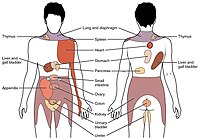
Photo from wikipedia
Background Using longitudinal data from the Cultural and Psychosocial Influences on Disability (CUPID) study, we have previously shown that disabling low back pain (LBP) was strongly predicted by the earlier… Click to show full abstract
Background Using longitudinal data from the Cultural and Psychosocial Influences on Disability (CUPID) study, we have previously shown that disabling low back pain (LBP) was strongly predicted by the earlier extent of pain at other anatomical sites. However, this could have occurred simply because some individuals had a lower threshold for reporting pain and associated disability. Methods To explore whether the association extended to sickness absence because of LBP, we analysed further data on 8,610 CUPID participants from 45 occupational groups in 18 countries. A baseline questionnaire assessed potential risk factors, including general propensity to pain, which was characterised by the number (from 0 to 9) of anatomical sites other than low back that had been painful in the past year. Logistic regression was used to assess the associations of these factors with sickness absence for LBP in the month before a follow-up questionnaire some 14 months later. Results Absence at least partially due to LBP was reported by 439 participants, and after allowance for potential confounders, was strongly associated with baseline pain propensity (ORs up to 2.6, 95% CI 1.7–4.0). For absence attributed entirely to LBP (235 participants), risk estimates were somewhat lower, but still significant (ORs up to 1.8, 95% CI 1.0–3.2). Conclusions After adjustment for other known and suspected risk factors, sickness absence because of LBP is importantly determined by propensity to musculoskeletal pain more generally. This reinforces the need to identify the drivers of general propensity to musculoskeletal pain, which shows large international variation.
Journal Title: Occupational and Environmental Medicine
Year Published: 2017
Link to full text (if available)
Share on Social Media: Sign Up to like & get
recommendations!